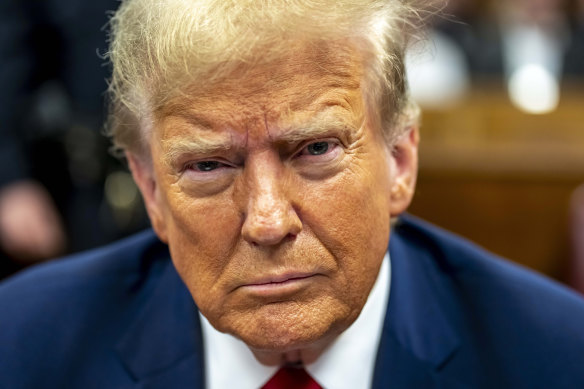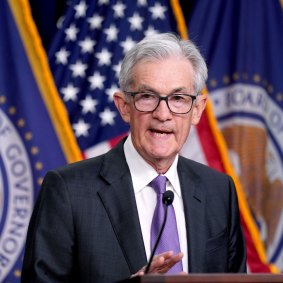This was published 10 months ago
Opinion
Trump’s think tanks are planning an assault on the Fed’s independence
Stephen Bartholomeusz
Senior business columnistIt’s no secret that conservative think tanks in the US are drawing up detailed plans for a radical overhaul of the US bureaucracy and institutions if Donald Trump regains the presidency. Those plans apparently include a fresh attempt to gut the Federal Reserve Board’s independence.
A Wall Street Journal report detailing those plans has generated consternation in the US over the past few days, despite efforts by Trump’s official advisers to distance him from them.

Former president Donald Trump’s official advisers are trying to distance him from reports of plans to erode the Federal Reserve Board’s independence.Credit: AP
According to the Journal, the proposals being discussed in a 10-page document put together by former Trump White House officials could mean Trump himself is consulted on interest rate decisions, with the chair obliged to seek his views and promote them to the Fed’s Open Market Committee, which makes monetary policy decisions.
The Fed’s chair, Jerome Powell, would be removed from that position before the scheduled end of his term as chair in 2026; the central bank’s use of its regulatory authorities would be subject to review by the White House and the Treasury department would be given a stronger role in overseeing any emergency lending programs in which the Fed was involved.
Trump has made it clear that he doesn’t trust Powell. Earlier this year he accused him of being “political” and said he thought he would do something this year – cut interest rates – to help Joe Biden and the Democrats. He said that when Powell’s term as chair ended, he wouldn’t reappoint him.
During his presidency, when the Fed was raising interest rates and withdrawing liquidity from the US system in 2018 and 2019, Trump threatened to sack Powell and explored the mechanisms for doing so, only to be told that he didn’t have that authority.
He also tried, but failed, to stack the Fed’s board with a series of controversial nominees – a pizza company executive, an economist being chased by the Internal Revenue Service for unpaid taxes and an economist who wanted a return to the gold standard and questioned whether the US needed a central bank.
Whether it’s with Trump’s encouragement or not (he does have a few other issues on his mind at present), the proposed assault on the Fed’s independence is consistent with the broader agenda being put together by conservative groups who feel a lack of preparation undermined the previous Trump administration’s ability to remake the governance of the US.
It’s also probably a prerequisite for some of the policies he has espoused, most notably his plan for a universal tariff, a complete ban on imports of essential goods from China and mass deportations of immigrants. He also wants another round of tax cuts for companies and the wealthy.
Tariffs are essentially a tax on domestic consumers, who pay for them via higher prices. Tax cuts for the wealthy translate to higher levels of spending. Deporting the immigrants who provide low-cost labour would increase companies’ employment costs.
Even an attempt to shake up or coerce the Fed into pursuing Trump’s preferred low-rate, loose money policies would unsettle financial markets.
Those policies would be inflationary. The current Fed would inevitably have to respond with higher interest rates and tighter monetary policies. There would be a collision between the White House and the central bank – unless the White House had gained real influence over the bank.
The Fed’s distance from politicians is a matter of law and structure. Its governors are appointed for 14-year terms (more than three US political cycles) and, while the president appoints the chair when a vacancy arrises, it is the governors and the other members of the Open Market Committee that decide who chairs the body that actually makes monetary policy decisions. Even if removed as Fed chair, Powell can remain a governor until 2028.
Nevertheless, attempts by the White House to direct the central bank aren’t unprecedented.
Arthur Burns was a chair of the Fed in the 1970s when Richard Nixon, who had appointed him, pressured him to adopt an expansionary monetary policy stance even though the inflation rate was relatively high.
Whether it was that pressure, or concern about instability within the US financial system, or his own Keynesian convictions, he did what Nixon wanted.
Inflation took off, and it took Paul Volker, a federal funds rate that reached 20 per cent and a nasty recession to bring raging inflation – it peaked at almost 15 per cent in 1980 – under control.
Apart from that episode during Burns’ chairmanship, the Fed has positioned itself as being studiously apolitical.
It has both raised and lowered interest rates in the lead-up to US elections when the economic data dictated, whether that suited the incumbent administration or not.
The implications of Trump’s agenda, if he were to regain the presidency, and whether and how the Fed might be forced to respond to it, matter beyond America’s borders. The US economy, US interest rates, US financial markets and the US dollar in particular have significant influence on economic settings and policies elsewhere.
There are, as Trump discovered in his last term, significant legal and institutional obstacles to any White House attempt to direct the Fed. He can, for instance, only fire Powell for “cause,” or for “inefficiency, neglect of duty or malfeasance in office”. A difference of monetary policy opinions doesn’t quite qualify.
Nevertheless, even an attempt to shake up or coerce the Fed into pursuing Trump’s preferred low-rate, loose money policies would unsettle financial markets.

Trump has made it clear that he doesn’t trust Federal Reserve chair Jerome Powell.Credit: Bloomberg
In recent decades, there has been a developed world consensus that the key objective of a central bank is to maintain price stability, with a secondary objective for some central banks of maximising employment.
That involves setting policies that target long-term goals – well beyond the political cycles – and it produces predictable responses to changes in economic conditions.
It is obvious to everyone, for instance, that the Fed would like to cut US interest rates this year as economic growth is slowing, but it won’t do so until the inflation rate is clearly and sustainably tracking towards its target of 2 per cent. A rate cut might help Joe Biden while maintaining, or even raising, rates would boost Trump, but that’s not a factor in its decision-making.
If the Fed, or any other central bank, isn’t seen to be independent and focused on clear policy goals, it would lose control of inflation expectations and inflation outcomes. Financial markets, driven by the lack of policy certainties, would become more volatile.
For the US, with its debt and deficits steadily heading towards levels that could only be sustained by the dollar’s primacy and the haven status of its Treasury bond market, any question mark over the Fed’s independence would lead to, at best, higher market interest rates and, at worst, a dearth of foreign investment in Treasury bonds that would force rates even higher and/or precipitate a debt crisis.
Trump’s instincts might be to sack Powell, if he can, and replace him with someone who can help bring the Fed into line with his own economic preferences, but the practical obstacles and the potential damage if Powell and his fellow governors resisted might deter him.
He does have some advisers and big donors who could be expected to see the risks of an assault on the Fed’s independence, no matter how frustrating that independence might be to Trump’s authoritarian instincts.
Read more:
- Two Australians had ringside seats to Trump’s 2016 ‘catch and kill’ plot
- Why the US dollar is setting off alarm bells around the world
- ‘RAGING!’ Trump pounces as Biden gets some bad news
The Business Briefing newsletter delivers major stories, exclusive coverage and expert opinion. Sign up to get it every weekday morning.